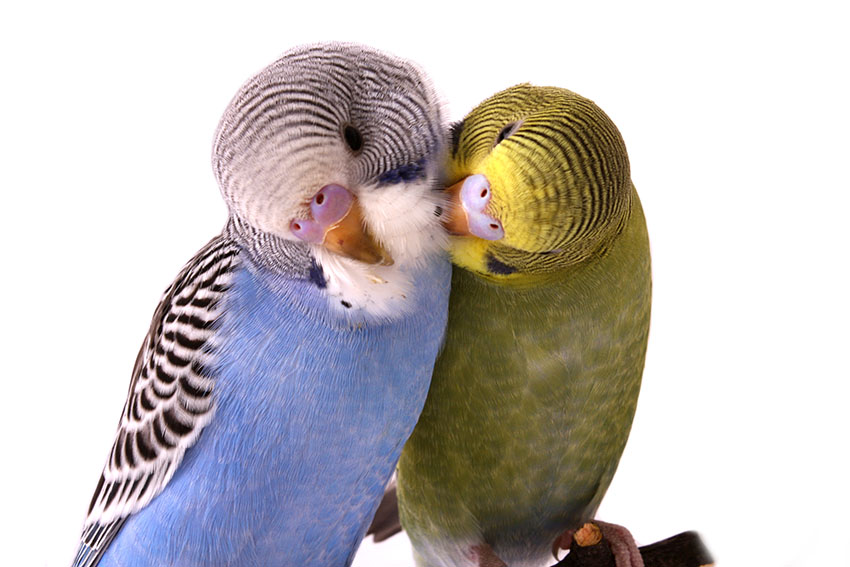How to Care For a Budgie
Budgies make wonderful pets. Not only will their beautiful plumage brighten up any room, they are also very intelligent and sociable, and will develop strong bonds with their owners. Like with all pets however, they come with responsibilities, and it is now your job to make sure they stay healthy and happy. Here are the most important things to think about if you’re new to budgie keeping:
FOOD AND WATER
Try giving your budgies the nutritional equivalent of what they would eat in the wild. The basis of their diet should be a good quality seed mix, and they should always have access to water and a cuttlefish bone. Leafy greens and herbs provide vitamins and minerals, and can be given a few times a week. Only feed your budgie fruits once a week, as they are high in sugar. Food and water containers must be refilled every day, and washed a few times a week.
Twice a year your budgies will moult, and their plumage will gradually fall out and grow back. To help them keep healthy during this time it’s important that the budgies get extra moulting vitamins in their water.
Like most pets, budgies prefer clear routines in their lives. Try feeding and letting them out of the cage around the same time every day, and if you want to put a cover over the cage at night time, it’s best to do this every day. This way the budgies will know what’s happening around them and feel comfortable in your presence, which will minimise stress and anxiety.
 STIMULATION
STIMULATION
Budgies are very sociable creatures, and it’s always best to keep them as a pair, preferably two siblings of the same sex who are used to living together. If you just want one budgie, you will need to act as its friend and companion, and spend a lot of time together with your pet.
Most budgies like to bathe. In the wild the main purpose of the bath would be to clear dust and sand from their feathers and to cool off, and even if your budgies probably won’t have these daily requirements, they will enjoy splashing around in the water. You don’t have to have a bath in the cage, instead you can put a bowl of water somewhere in the room where the budgies are flying, but if you do it’s important to change the water as soon as it gets dirty. If your pet doesn’t seem interested, an alternative to bath time is a budgie shower. Hang some wet leaves (lettuce, basil and parsley are favourites) in the cage, and watch your budgie run through them.
The budgies should be offered the opportunity to fly freely (but supervised) outside the cage every day, at least 45 minutes, but ideally a few hours. Make sure the room is budgie proofed before your let your pets out. Close windows and doors, block off fireplaces, turn off fans and air conditioners and keep other pets out of the room. Budgies are intelligent, very sociable and active birds who will enjoy spending time with you and the rest of the family.
CAGE CHECK
Check the cage weekly to see that everything is in place and nothing has broken. Perches must be kept clean and fully functioning. Toys are great for mental stimulation, they encourage physical exercise and wear the beak down. Change the toys every now and then to keep your budgie interested. You don’t have to buy new toys all the time, but rotate the ones you’ve got regularly and throw in a new one every now and again.
HEALTH CHECK
Budgies’ beaks and nails grow constantly throughout their lives, so it is important that they have access to toys to grind them down. In most cases you will have to trim the nails when they get too long, so make sure to purchase a pair of clippers suited for the task.
Budgies, like other pack animals, are very good at hiding pain and illness, so it’s important to give your pet regular health checks. When you get to know your budgie, it’ll be easier to spot irregular behaviours.
Normal signs of illness include changes in weight, discoloured feathers, reduced interaction with humans and toys, scabby nostrils and missing feathers around the eyes. Another way of spotting early signs of illness is to regularly check your budgie’s droppings. The disposable paper liners in the Geo bird cage makes it easy to monitor your pet’s health. When you do your weekly clean, check the amount, colour and texture of the droppings. They can vary somewhat depending on what your budgie has been eating, but all faeces should be firm, and the urine part transparent and clear. If you notice clear changes, or have other reasons to suspect that your budgie might be ill or in pain, contact your vet as soon as possible. Make sure to find a vet that specialises in small animals, ideally as soon as you take the budgie home, so you know who to contact if something goes wrong.
If you need more information, check out the section on budgie illnesses in our guide.
No comments yet - Leave a comment
This entry was posted in Budgies on April 30th, 2020 by linnearask
